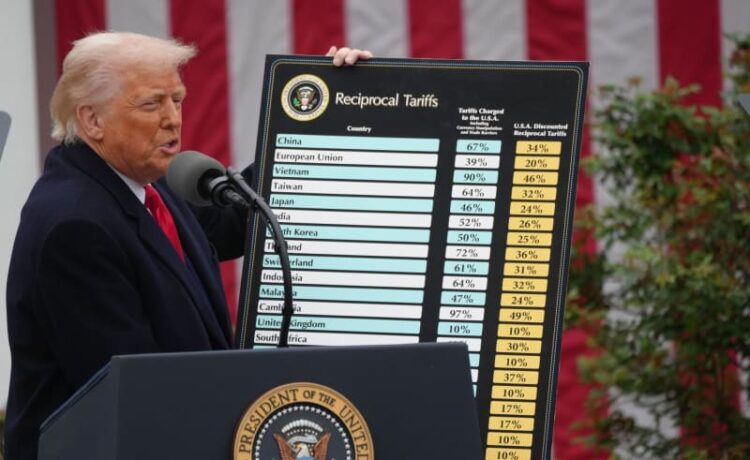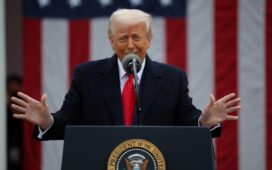US trading partners reacted on Thursday to President Donald Trump’s new sweeping global tariffs announcement with a mixture of calm, disappointment, sadness and anger.
The European Union and China immediately announced countermeasures but are also seeking dialogue. Others, such as India, opted for a wait-and-see approach.
The US government is introducing new universal tariffs of a minimum of 10% on imports from all countries, with significantly higher punitive tariffs applying for some, depending on trade deficits.
Imports from Germany and other EU countries to the United States will face new tariffs of 20%.
“THE OPERATION IS OVER! THE PATIENT LIVED, AND IS HEALING,” Trump wrote on his social media platform Truth Social, the day after his landmark announcement.
Toughest US tariffs yet
This is the most aggressive step yet in Trump’s already combative trade policy. Economists have said that US consumers will experience significant price increases, but consumers in Europe and other parts of the world will also feel the pinch.
Stock prices fell in New York, Tokyo and Frankfurt, with the price of gold reaching a record high and the euro gaining further on the dollar.
European Commission President Ursula von der Leyen said the universal tariffs represent a severe blow to the global economy, with immense consequences expected.
Speaking on the sidelines of a summit with Central Asian leaders in Uzbekistan, von der Leyen warned that the tariffs would drive up grocery, medication and transportation costs for millions. She added that rising inflation would hit the most vulnerable the hardest.
Worried that other producers would now seek to sell to the EU, von der Leyen said the EU cannot absorb global overcapacity or accept dumping on its markets,
It is not too late for a negotiated settlement, she said, appealing to the US to engage in talks. The goal must be to reduce trade barriers, not increase them.
European negotiators had tried to prevent the new tariffs during talks in Washington but were unsuccessful.
Trump has often complained that the EU is “ripping us off” and has expressed his frustration that European companies sell significantly more goods in the US than American companies sell in the EU.
The previously announced US tariffs on steel and aluminium imports, as well as car imports, had already escalated the trade dispute with Europe.
Trump pleased with himself
Back in Washington, Trump posted on his Truth Social network that he thinks the US is on the right track following the announcement of his massive tariffs.
He claimed that the “PATIENT WILL BE FAR STRONGER, BIGGER, BETTER, AND MORE RESILIENT THAN EVER BEFORE.”
The New York Stock Exchange disagreed, as the Dow Jones Industrial Index fell by 2.7% at the start of trading in a large scale sell off.
Losses were even greater on the NASDAQ 100 tech exchange, where stocks plunged by 3.9% to 18,828 – its lowest level since September 2024. The NASDAQ has now lost 10% in value so far this year.
The S&P 500 fell 3.2% to 5,487 points, also hitting its lowest level since September 2024.
Reciprocal tariffs?
Washington argues that it is merely raising tariffs wherever international partners impose duties or other trade barriers on US companies. This, they claim, is only fair.
But how the US is calculating this so-called unfairness remains opaque, making the “fairness” of the move difficult to assess, Rolf Langhammer, an economist at the Kiel Institute for the World Economy, told dpa.
“We don’t know how US President Donald Trump arrived at these figures,” he said. “We are still in the dark.”
Trump is likely attempting to factor in so-called non-tariff trade barriers, Langhammer theorized. The economist cited hormone-treated beef, which cannot be legally imported into the EU from the US. Trump simply attaches a price tag to such restrictions, Langhammer explained.
Unequal tariffs on Ukraine, Russia
Russia, which launched a full-scale invasion of Ukraine more than three years ago, was not included because US sanctions already “exclude any significant trade,” Trump spokeswoman Karoline Leavitt said.
Ukraine, on the other hand, was slapped with punitive tariffs of 10%.
In reality, however, the US still imports more goods from Russia than from Ukraine.
India staying patient
India’s Department of Commerce said it was examining the implications of the tariffs, and “also studying the opportunities that may arise due to this new development in the US trade policy,” it said in a statement.
It added that discussions were being held between teams from the US and Indian governments for an early conclusion of a “mutually beneficial” bilateral trade agreement. “We remain in touch with the Trump administration on these issues and expect to take them forward in the coming days,” the statement added.
Trump and Indian Prime Minister Narendra Modi announced at a meeting in February this year a goal of doubling bilateral trade to $500 billion by 2030.





